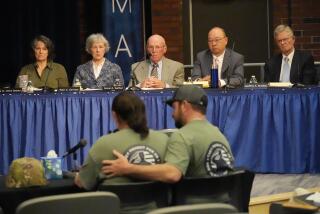Moving On in Space
- Share via
The conclusions of the Rogers Commission on the space-shuttle accident have been known for weeks. Now that they have officially been made public, it is time to implement the commission’s recommendations and move ahead with the space program--one of this century’s most impressive achievements. Though the tone of the 256-page report was softened and some of the sharpest criticisms of the space agency were left out of the final draft, the report leaves no doubt that the Challenger was destroyed by a design failure that was compounded by a NASA management failure.
Because the commission’s work was conducted largely in public and the commissioners discussed their findings as they went along, the report contains few surprises. The Marshall Space Flight Center in Huntsville, Ala., which oversees rocket development in the space agency, was properly criticized for ignoring evidence of problems with the booster-rocket seals that caused the Challenger to explode shortly after launching on Jan. 28, destroying the ship and killing its seven-member crew. The director of the Marshall center, William Lucas, has announced plans to retire. Morton Thiokol Inc., the builder of the booster rockets, was also criticized for playing down recurring problems with the joints, which are now being redesigned.
But one problem that cannot be fixed so easily is avoiding the cockiness that comes from years of success. This attitude blinded NASA to the ongoing possibility of failure. For 25 years the agency had known nothing but triumph, so it was easy for managers to brush aside the concerns of engineers about the effect of cold weather on the O-ring seals in the rocket joints. In the future the seals will no doubt get the right amount of attention, but what about other components that may be just as risky--though no one will know it until after the fact?
The 13-member commission, chaired by William P. Rogers, has done excellent work in getting to the bottom of the Challenger disaster. It concluded that the accident could have been avoided, but it reiterated the national commitment to the manned exploration of space, which was a worthwhile endeavor before the accident and remains a worthwhile endeavor now.
But there is no need to rush things. James Fletcher, the NASA administrator, says that the shuttle will resume flying in a year or so. That schedule should be determined by the time it takes to make the necessary changes and improvements. If it takes longer than a year, there should be no pressure to meet a schedule and show the country and the world that the shuttle is reliable. That’s the kind of thinking that helped doom the Challenger.
Nor does there seem to be much real need for the country to spend more than $3 billion to build a replacement for the Challenger. If routine satellite launches are handled by conventional rockets, as the Rogers Commission correctly recommends, three remaining orbiters should be enough to handle the remaining cargo manifest.
It is tragic that it took the loss of the Challenger and its crew to wake up NASA, Congress and the country to the deficiencies in the space program. It is now up to Congress to make sure that the agency does not slide back into its lackadaisical ways.
More to Read
Sign up for Essential California
The most important California stories and recommendations in your inbox every morning.
You may occasionally receive promotional content from the Los Angeles Times.













